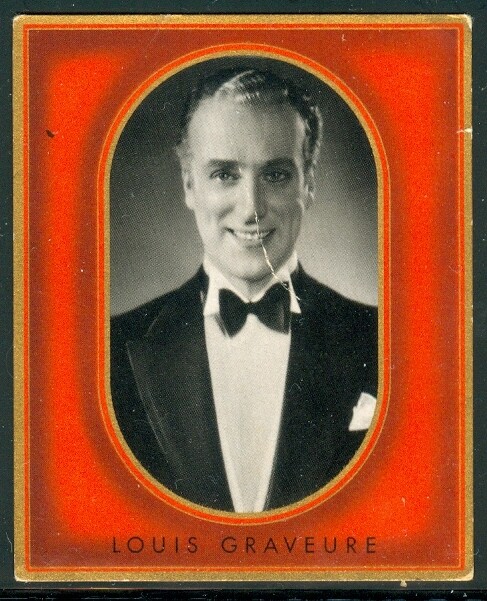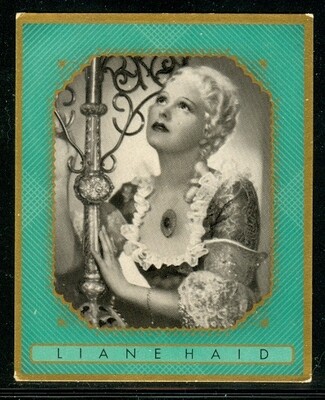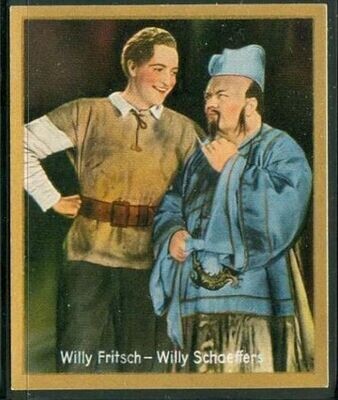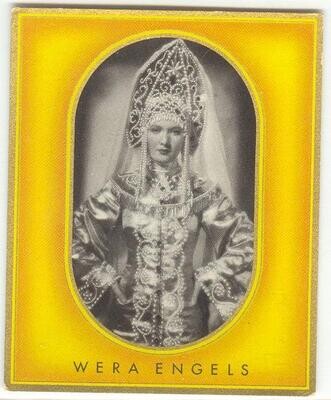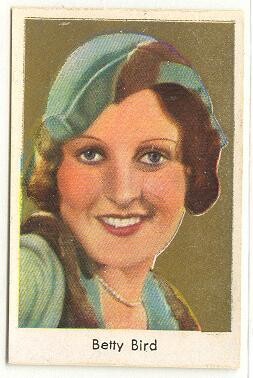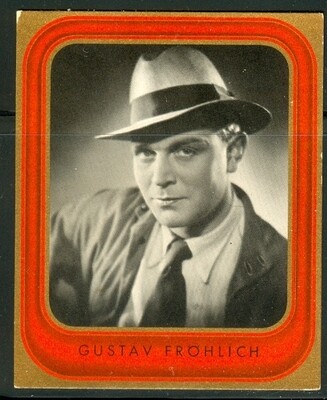
1936: Louis Graveure, the mystery man, vintage Filmbilder cigarette card #171
Louis Graveure ~ This card is from the Bunte Filmbilder series from 1936. Card is #171 in excellent condition, VF. About 2¼"x2¾".
Louis Graveure (1888-1965) born Wilfrid Douthitt in London. He made his New York debut as Wilfrid Douthitt in 1914 in an operetta called The Lilac Domino, opposite Eleanor Painter, and received enthusiastic notices. In 1915, a baritone resembling Douthitt but called Louis Graveure made his New York recital debut. The press was curious to know if Graveure was, in fact, Douthitt. Even after a member of the press knocked on Graveure's apartment door, held up a photograph for comparison, and pronounced that, without the camouflage of his recently grown goatee, Douthitt and Graveure were the same singer, Graveure denied it emphatically. He proclaimed himself Belgian. Thus began one of the better promotional strategies of the twentieth century. Thereafter known as "the mystery man," Graveure capitalized upon this notoriety at every possible juncture. (His mother's maiden name was Graveur.)
Following a 1915 debut, his glorious voice and great store of genuine feeling captivated public and press alike. He made a yearly western concert tour and produced over forty recordings in the next fifteen years for Columbia, some of which sold very well. Schirmer published his manual of singing called Super-Diction in 1918. He became accustomed to riding about New York City in a chauffeur driven limousine.
He married Eleanor Painter in 1916. She had trained in Berlin, and was considered a very fine operatic soprano. She made her debut as Madama Butterfly in 1912 at Deutsche Oper and continued singing repertory in that Fach both in the U.S. and Europe during her married life. From 1920, Louis Graveure, too, sang recitals and operatic performances in Berlin. Eleanor divorced Louis in 1930, subsequently marrying a wealthy businessman.
Without warning, Louis Graveure made his debut as a tenor in 1928. Critical reaction in New York was somewhat mixed. He had possessed strong top tones as a baritone, but the critics noted that when he sang exclusively in the tenor range there was a certain hardness of quality. This move may have been a reaction to his waning popularity. After some years teaching privately during summers in San Francisco (Ramon Navarro, silent film star, studied with him), he took an endowed chair in voice at Michigan State University in 1928, perhaps verifying the observation by Time magazine that he, among many other famous singers of the period, was not being booked as frequently. The decision to emigrate to Berlin in 1931 to sing at Deutsche Oper may have been motivated by the decline in bookings, the crash of 1929, the divorce from Painter, dissatisfaction with teaching, and a lucrative German contract.
Louis Graveure sang five roles, predominantly, at the Berlin house: Faust, Rodolfo, Pagliacci, Don José, and Lohengrin. Because of his magnetic stage presence, electric delivery, handsome face, and athletic physique, even at forty-three, he was enormously popular with the Berliners. This led to a series of four films, and in the second of those films, made in 1934, called Ein Walzer für Euch (A Waltz for You), he played opposite the famous film star, Camilla Horn. When Goebbels took over Deutsche Oper in 1934 as an arm of the Nazi propaganda ministry, elements of these films were used as propaganda.
Graveure's liaison with Camilla Horn lasted four years. They were adored by the public, living in Horn's luxurious villa in Berlin, and, when not working, in her villa on Cote d'Azur. But, war was not far off. Graveure left Berlin for that villa in France in 1938 and did not return. A telegram he sent to Horn from there was intercepted, and the Gestapo agent who delivered it told Horn that Graveure was suspected of espionage. Her Berlin villa was searched and her car interior destroyed in the quest for incriminating material. None was found. Louis Graveure attempted to leave France for a U.S. concert tour in 1940, shortly after the Nazis marched into Paris. He was diverted instead to England where he stayed for the duration of the Second World War.
In 1947, Louis Graveure reentered the United States, this time accompanied by a new wife, Patricia, and a two year old child named Viola. He attempted a comeback recital in New York that year, but judging from the critical reaction, the years of singing as a tenor had taken their toll and the recital was not a success. It is believed that the Graveures lived in New York until around 1957, when they moved to Los Angeles. Lest anyone think that Louis Graveure spent his final days penuriously there, it should be noted that he and his family lived in the luxury apartment building, Villa Carlotta, home to many movie studio contract players. There he taught voice privately, perhaps by referral from the film industry contacts he had made through Ramon Navarro and Camilla Horn. He was seventy-seven in 1965 when he died.
This lot consists of a genuine German cigarette premium issued between about 1930 and 1937. In general, German cigarette cards and premiums make an interesting and inexpensive addition to any collection. The Nazi government of Germany opposed smoking and eventually put an end to cigarette cards. As a result, the native German card collecting hobby never developed to the extent of that in Britain or the United States. As a result, most German premiums and cards cost only a fraction of what might be expected from their American and British cousins.
Large photos are shown smaller than actual size while small ones are generally enlarged to as much as twice their original size. Almost all photos and cards are scanned through protective sleeves or pages which tends to cut the clarity a bit. Enlarged defects tend to look worse than they actually are.
